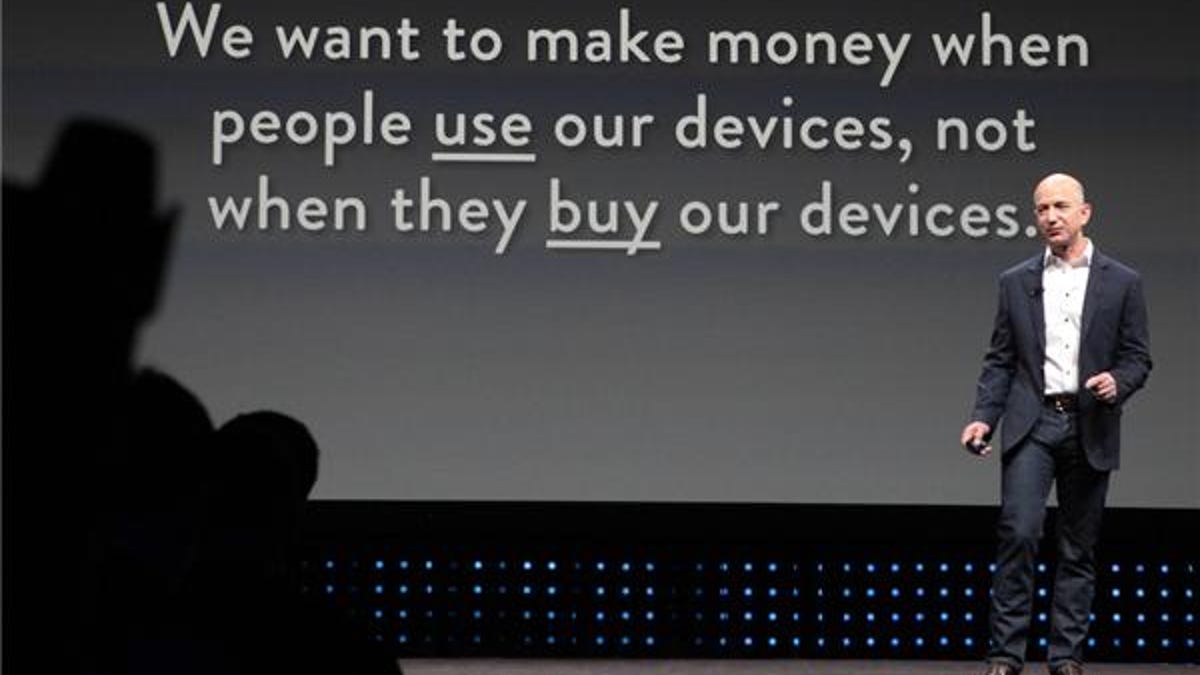Kindle Fire HD: Amazon's anti-Apple profit engine
The three new Kindle Fire HD tablets are the latest example that Amazon isn't interested in making money off of its hardware, a far cry from Apple's strategy.

Amazon CEO Jeff Bezos may model his presentation skills after the late Steve Jobs, but his company's business model looks more like the Bizarro version of Apple.
Take today's announcement of several new Kindle Fire tablets, as well as a discounted price on the original. Amazon is hardly making a large profit on these competitively priced products, something Bezos is quick to own up to.
"We want to make money when people use our devices, not when they buy our devices," he said during an event in Santa Monica, Calif., today.
The three versions of the Kindle Fire HD represent an expansion of the company's strategy with the original Kindle Fire. Amazon worries about getting the tablets into the hands of its consumers first, and then focuses on making money off of the services and products it can deliver to them later. While Bezos denies this is the razor-and-razor-blade model, it's actually an apt analogy.
With the high-definition version of the Kindle Fire coming out, Amazon is hoping the more beautifully rendered online store will only spur further interest in Amazon Prime, e-books, or other goods and services. If the first Kindle Fire was a mobile storefront in the hands of consumers, the Kindle Fire HD tablets represent an even better looking one.
"Amazon's services are the core of its devices, and the devices enhance Amazon's service: a virtuous cycle where Amazon gains an increasing share of consumers' wallets," said Forrester Research analyst Rotman Epps, adding that subscription services are key to the company's future success.
Amazon's model, of course, is antithetical to Apple's approach of generating its profit of the hardware. Everything Apple does, from the iTunes music store to its App Store and iCloud service, drives sales of the phones, tablets and computers that are its primary money-makers. Considering the industry-leading margins on those products, it's a no-brainer.
But in the battle for the consumers' credit card, Amazon has the edge. A recent survey conducted by Forrester found that nearly a third of respondents had a credit card on file with Amazon, compared to 18 percent with Apple and 5 percent with Google.
The models are poised to clash if Apple moves into the smaller tablet arena with a lower-priced iPad Mini.
Amazon has prepared itself as well as it could. The company unveiled three versions of the Kindle Fire HD, a 7-inch version for $199, a larger 8.9-inch version for $299, and a 4G LTE-enabled version for $499.
The Kindle Fire HD was clearly the star of Amazon's event, which also saw the unveiling of a new Kindle Paperwhite e-reader that works in the dark, a discounted non-touch Kindle, and an update to the original Kindle Fire at a lower $159 price tag.
"We want to have the best tablet at any price," Bezos said.
Amazon already fired a shot across Apple's bow with its $499 Kindle Fire, which Bezos compares directly to the iPad. He argued that the total cost of the Kindle Fire plus its $50 annual data plan -- $549 -- put it well iahead of the $959 that it would cost for an iPad and LTE data plan for the first year.
It's an interesting comparison, but the plan Bezos speaks of includes only 250 megabytes of data each month, enough for e-mail and Internet browsing, but not heavy streaming video. In that respect, Amazon may be overreaching there.The lower end Kindle Fire HD tablets, however, answer Google's challenge, which it had thrown out with the $199 Nexus 7, which has been a critical darling for its use of Android 4.1, or Jelly Bean, in a small and affordable package.
Part of Amazon's answer, apparently, was to go bigger. The 8.9-inch Kindle Fire HD, as its name states, has a resolution of 1900 by 1200 (the 7-inch version has a 1280 by 800 resolution), a display that the company promises will have 25 percent less glare, a sharper and better contrast in images, and a "laminated touch sensor." The tablet also has a faster OMAP processor from Texas Instruments, which CEO Jeff Bezos compared favorably to Nvidia's Tegra 3 processor found in many high-end mobile devices.
In addition, the tablet will have 16 gigabytes of storage, Dolby speakers, a rear and front-facing camera, and two WiFi antennas for what Bezos said would allow for better reception.
Bezos also spent much of the presentation running through the other new features of the Kindle Fire HD, including Whispersync for Voice, which allows you to pick up where you leave off with audio books, just as you do with e-books. The same concept applies for Whispersync for Games. Other features include better e-mail support and Kindle FreeTime, a handy tool that sets screen time limits for kids.
The improvements will certainly help it compete against the Nexus 7, which fared better against the original Kindle Fire than Amazon's newest lineup. In addition, the new Kindle Fire tablets benefit from one of the largest storefronts in the world in Amazon's homepage.The real games begin when Apple enters the fray with a smaller iPad.

